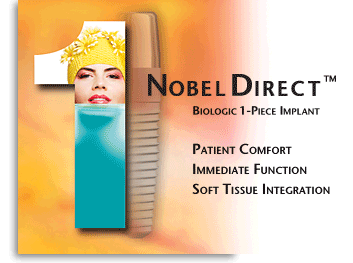 |
|

One day Implant
Brånemark System
®
and
Replace® Implants are FDA cleared for immediate function
for all indications. First from Nobel Biocare
language |
l |
THAI |
|
|
QUESTIONS & ANSWERS
Q: What does Nobel Biocare mean with Immediate Function?
A: The term "Function" was selected as it reflects the patient's perspective at
implant treatment: Teeth in "function" immediately after implant placement.
Q: What is immediate and what is early?
A: Immediate is within the same procedure (within the same day as the surgery)
and early is anything later, but before the recommended of 3-6 months. "Early"
should be specified from case to case.
Q: The
scientific references show good results with immediate function, but how
about the results in daily clinical practice? Is it not a higher risk with
immediate function?
A: If the prescribed inclusion/exclusion criteria and protocols are followed,
the success rate is similar to that for the two-stage approach. The TiUnite™
and HA surfaces play an important role for this positive outcome.
Most of the clinical studies on Immediate Function are short-term, but it is
believed that after the first year of function and bone healing, the
prognosis is the same as for the two-stage approach.
Q: In
case of complication and litigation, does the FDA clearance have any bearing?
A: No. FDA has only cleared the product for commercial distribution in U.S.
based on information from Nobel Biocare, demonstrating the safety and
efficacy of the product according to its claims. The user is always
responsible for the treatment of the patient.
Q: What is the contingency plan when there is a failure with immediate
loading?
A: If one of several implants is lost one may in some cases proceed without
that implant. If a crucial implant is lost it can be replaced, immediately
with a larger diameter or later with the same diameter.
Q: What are the indications?
A: Candidates for any implant treatment where high implant stability can be
achieved and the implant loading can be controlled in the same manner as for
a conventional two-stage treatment. See further the Nobel Biocare Immediate
Function Guidelines..
Q: Which is the best indication to start with?
A:Partially edentulous patients, from pre-molar to pre-molar in non-esthetically
demanding positions and fixed lower bridge or overdenture on implants
between mandibular foramina.
Q: What factors in treatment planning are important?
A: There should be sufficient bone at the implant site to allow for a good
initial stability. The occusal conditions should be possible to control,
i.e. avoiding extreme bruxers, unstable adjacent teeth, long cantilevers
etc.
Q: How do I know when an implant is stable enough for immediate function?
A: When an implant insertion torque of 35 45 Ncm is achieved before the final
seating of the implant neck at the bone ridge.
Q: How does the soft bone react on immediate loading?
A: If an implant with the TiUnite™ surface is used and if the initial stability
criterion is reached the implant is likely to have a good prognosis also in
soft bone.
Q: Are bone defects exclusion criteria?
A: No. Not as long as the initial implant stability criterion is reached.
Q: What sort of implant do I have to use for immediate function?
A: All Nobel Biocare NP and larger diameter implants are approved for immediate
function, but those with TiUnite™ surface are recommended.
Q: What is the best surface for immediate function to use?
A: The best results are achieved with the highly osseoconductive surfaces
TiUnite™ or HA.
Q: Does the surgical steps/site preparation differ compared to conventional implant placement?
A: Firm initial stability is of utmost importance. This can be achieved by
using tapered implants and/or under-preparation techniques for the parallel
wall implants
Q: How should one check the initial implant stability?
A: The clinical documentation shows that high initial stability is indicated by
insertion torque values of 35-45 Ncm before final seating of the implant.
Most published studies on immediate function have not used RFA or Periotest
measurements and clear guidelines how to use these techniques are presently
missing.
Q: Isn't there a high risk with immediate function in fresh extraction sites if
the extracted tooth was removed because of infection?
A: If the socket is curetted and perfectly cleaned from soft tissue remnants
and an adequate stability is reached, the prognosis is likely to be good.
However, more clinical documentation is called for at this situation.
Q: In a 3-unit bridge, can an immediately loaded implant be immediately connected
to a natural tooth?
A: Probably yes, provided the tooth is stable, but this specific therapy is not
clinically documented as yet.
HOME
l SERVICE
l DENTISTS
l TECHNOLOGY
l FACILITIES
l ABOUT US
l SITE MAP
PROMOTION
l PRICE&DURATION
l CONSULTATION
l FAQ
l LINKS
l MAP
l TESTIMONIALS
l OUR LAB
l RESOURCES
DENTAL BRACES
l LASER TEETH WHITENING
l IMPLANT DENTISTRY
l ENDODONTICS
l OPERATIVE DENTISTRY
l SEDATION DENTISTRY
COSMETIC DENTISTRY
l PROSTHODONTICS
l PERIODONTICS
l ORAL SURGERY
l PAEDODONTICS
l GP & ORAL EXAM
l OCCLUSION
DENTAL OFFICE
l DENTAL CLINIC
l COSMETIC DENTISTRY
l COSMETIC DENTIST
l TEETH BLEACHING
l TOOTH WHITENING
DENTAL CROWNS
l DENTAL IMPLANTS
l DENTAL TREATMENT
l DENTAL IMPLANT
............................................................................................................................. Copyright© 2004 SILOM DENTAL BUILDING. All Rights Reserved.
Local Call : 0 2636 9092-5, International Call : (+) 66 2636 9091, (+) 66 2636 9097
e-mail :silomdental@silomdental.com
Dental Implant, Dental Implants, Implant, Dental Implant Bangkok, Dental Implants Thailand, Implant Dental Center, Implant Bangkok Thailand
